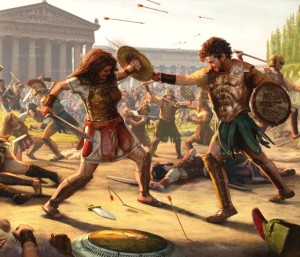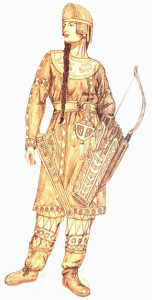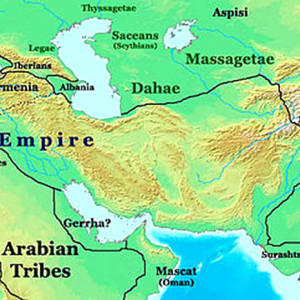Welcome to Amazon Month, Week 1!
First, let’s talk about the mythical Amazons.
They originally show up in Greek legend as a race of warrior-women who eschewed the company of men except once a year, when they would all visit a nearby town and seduce the men in hopes of conceiving children. Daughters were kept and valued, while sons (depending on the story) were either killed, abandoned or returned to their fathers. Amazon girls grew up learning how to fight; focusing especially on the bow and arrow. As a sign of dedication to her sisters, and to make archery easier, an Amazon woman would burn or cut off her left breast as part of her rite of adulthood. The Amazons mostly kept to themselves, though would sometimes show up at important battles.
Now, there’s no evidence (outside the feverish imaginings of certain Greek authors) that a culture even remotely like the one I described above existed. Indeed, it’s easy to examine the legend and pick up on some sexual anxieties on the part of Greek men – the idea that women could not be warriors without sacrificing their femininity or eschewing marriage and men completely. After all, the idea that a liberated woman has little use for men beyond breeding seems to concern even some modern men anxious about female power.
Several Amazons do show up in Greek myth, though either as an obstacle to be overcome or a prize to be won by a man. Hippolyta, an Amazon princess, owned a magic girdle, which Hercules was tasked with obtaining as one of his Twelve Labors. But upon beholding the pillar of manliness which was Hercules, Hippolyta was reduced to a giggling schoolgirl and handed her belt over without a fight. She later died in a hunting accident, from a mis-cast spear thrown by her sister Penthesilea. Penthesilea felt so terrible about what she had done that she almost killed herself; only her culture’s strict prohibition against suicide kept her from the ledge. So instead, she packed up and joined the Trojan War, where she was promptly killed by Achilles. She doesn’t even get a cool battle scene – 15,000 lines in The Illiad, and Penthesilea mostly shows up as a dead body for Achilles to cry over.
But… where did the idea come from? After all, even the most outlandish tale needs some germ of inspiration in order to flourish!
Nowadays, most archaeologists and anthropologists believe that Greek traders encountered the Parthians and Scythians, gender-equitable Persian and Central Asian cultures (or at least, far more gender-equitable than the Greeks, who were actually kind of jerks to women). Gobsmacked by watching women walk around without a man to shepherd them, much less with their own weapons and armor, they took these fantastic tales home with them, and they grew (and were shaped by Greek attitudes) in the telling.
Parthian and Scythian territories covered much of what we consider the Middle East and Near East, touching Eastern Europe in some places and the western edge of Asia in others. So, just close enough to be trading partners, but far enough away from the main Grecian city-states to still seem exotic.
These were largely nomadic cultures, relying on the horse and bow to fight. And as it turns out, a lot of the gender differences which give men an edge in melee combat tend to disappear when one fights with a bow from horseback. As a result, most archaeologists think women often fought in Parthian and Scythian armies. However, it should be pointed out that most of these women likely didn’t make a career out of it. Graves containing female skeletons alongside weapons and armor have almost always been for woman who died young and without having given birth. Archaeologists assume therefore that warfare was for young women, with the cultural expectation that women who survived the would eventually settle down and become mothers.
These cultures also practiced several other customs which would have been utterly alien to the Greeks, particularly matrilineal descent. Children traced their heritage through their mothers, and men joined their wives’ households upon marriage. There’s some indication that a few sub-cultures (such as the one we’ll be discussing today) also practiced polyandry – the custom of a woman taking more than one husband, though a man generally only has one wife. And while sons were not necessarily ‘given away’, these cultures did practice fosterage, in which some sons were sent to live with neighboring clans in an attempt to strengthen ties and avoid inbreeding (medieval European nobility practiced the same custom).
Now that we have a solid grasp of the Amazons, let’s talk about Queen Tomyris.
Tomyris ruled the Massagetae, a sub-culture of the Scythians living in what’s now Afghanistan, Uzbekistan and Turkmenistan, ascending the throne after the death of her husband in the 6th century B.C.E.
Unfortunately, all we really know about her comes from Herodotus, a classical Greek historian. And so while it’s good to take his writings with a (large) grain of salt, he did generally get the ‘big picture’ correct.
The people of Massagetae lived a semi-nomadic, fairly pastoral life – though they were not a peaceful people. They were vicious fighters, rumored to kill (and possibly eat) their own elderly once they could no longer be productive workers. A huge part of their economy revolved around raiding their neighbors, kidnapping everyone who looked like they could swing a shovel or hold a broom, and selling them all into slavery. Despite being such a martial culture, however, they were A-okay with being ruled by a woman, as no one seemed to object when Queen Tomyris ascended the throne.
And, as luck would have it, another ruler was on the rise concurrent with Tomyris’ rule: Cyrus the Great. Cyrus, a Persian ruler, started conquering early in life and kept it up until he controlled nearly every acre of soil from the Mediterranean to the western edge of India. At the time, his empire was the largest yet formed in human history, and his war machine unmatched.
Until the day he met Queen Tomyris.
As a conqueror is wont to do, he decided the next addition to his Achaemenid Empire would be the lands of the Massagetae.
At first, he tried a peaceful arrangement, and proposed marriage. But Tomyris firmly rejected his offer – she rather liked her life as it was, and didn’t feel that becoming Empress was any step up from, you know, Queen of the Amazons (she had a point).
Cyrus, apparently, was one of those men who doesn’t handle rejection well. He coped by sending his army to the banks of the Syr Darya, the river which marked the edge of Tomyris’ territory. There, he made a big show of building a bridge which would allow him to march over and conquer Massagetae.
Tomyris, ever the gracious Queen, suggested perhaps he would prefer if they fought it out over in yon battlefield? She even sent one-third of her army out to go meet his.
Cyrus accepted, but he pulled a dirty trick. See, the Massagetaens had never really encountered wine before. So when Cyrus moved his army to meet Tomyris, he had his stewards leave behind many of their food stores… including their wine. The Massagetaen army thought they were having a party, courtesy of Cyrus, and proceeded to behave like every college kid on Spring Break who has yet to learn their limits.
Needless to say, this didn’t turn out well for them a few hours later, when Cyrus brought his army back. He did not elect to kill the drunk soldiers, but instead captured as many as he could, including Tomyris’ son Spargapises.
I am at this point reminded of a plaque which hung in my kitchen as a child. It read, “If Mama ain’t happy, ain’t nobody happy.”
Well, Mama Tomyris was deeply unhappy when she learned of the fate of her son. I will let the Queen speak for herself:
“It was this poison by which you ensnared my child, and so overcame him, not in fair open fight. Now hear what I advise, and be sure I advise you for your good. Restore my son to me and get you from the land unharmed, triumphant over a third part of the host of the Massagetai. Refuse, and I swear by the sun, the sovereign lord of the Massagetai, bloodthirsty as you are, I will give you your fill of blood.”
Unfortunately, when Spargapises recovered from his hangover, he was so ashamed at being captured that he killed himself (perhaps an early historical example of Fridge-Stuffing happening to a dude). And Cyrus wasn’t about to cede ground to a woman, either, otherwise he’d look like a chump in front of the other Greeks and Persians he ruled.
A few days later, then, Cyrus and Tomyris met again in battle. Tomyris had rounded up every fighter she could; doubtless a fair number of women made up her army.
They fought, and Tomyris’ army prevailed. Not only did her forces defeat the Persians, Cyrus himself fell in the battle. After the fighting was over, Tomyris had some of her soldiers find Cyrus’ body and bring it to her. She also ordered some other soldiers to bring her a vat, and fill it with blood collected from the battlefield. Once this had been done, she cut Cyrus’ head off and submerged it in the blood-filled vat. By this, the Queen of the Amazons declared, she had kept her promise to give Cyrus his fill of blood. She then cut the top of his skull off, and kept it as a trophy.
And Tomyris didn’t just keep his skull in a trophy case or something. No, Cyrus the Great, builder of the biggest empire humankind had yet seen, ended his days with his skull as Queen Tomyris’ favorite cup. From which she probably drank a lot of wine.
She largely disappears from the historical record after this. And since historians of the day only wrote things down when shit got real, we can assume that Tomyris lived out the rest of her rule in relative peace. The Massagetaens eventually grew into the Huns, famous eight hundred years later for ruining another famous empire.
The death of Cyrus did not damage the empire he’d built; the Achaemenid Empire remained stable for 300 years, falling only to Alexander the Great. At it’s height, the Achaemenids ruled an estimated 44% of the world’s population. Cyrus, it should be mentioned, was no better or worse than most rulers of his day – indeed, given his inclination towards tolerance, he was likely a great deal better. Among the Jewish people, he is revered as the leader who freed their ancestors from captivity in Babylon.
For her part, Tomyris has been a subject of fascination by scholars and artists, especially during the Renaissance. Many notable painters of that era used her for inspiration. However, she doesn’t show up in contemporary media, which is a bit of a shame. Take Back Halloween, though, has come through yet again, with another no-sew costume guide to dressing up as Tomyris for Halloween (or whenever you feel like getting your Amazon Queen on!).
The name Tomyris has also become quite popular for baby girls in Central Asia, so perhaps we’ll see the rise of another Tomyris soon (though hopefully without the cannibalism and slave-trading!).
And though Tomyris doesn’t show up herself in contemporary media, the legends of the Amazons persist. Since 1941, Wonder Woman has been inspiring generations of women to live a badass life. And, of course, who can forget Xena, the warrior princess who certainly channeled quite a bit of Amazonian warrior spirit?
However, far more important are the real women living today and assuming the mantle of the Amazons. The Asgarda of the Ukraine claim direct descent from the legendary Amazons (a credible claim – the Scythians did indeed range that far); and live as they believe their foremothers did. This woman-only martial arts collective has dedicated itself to the principles of female strength and sisterhood (with a healthy dose of Ukranian nationalism thrown in for good measure).
I would also like to call back to the fact that Tomyris’ kingdom was in present-day Afghanistan, and the Parthians once inhabited Iran and Iraq. And today, as you read this, women in those nations are taking up arms, joining their country’s militaries, and dedicating themselves to defense of their homeland. They fight ISIS, the Taliban, and any other threat to their homes and their families. Without a doubt, each and every one of these women is Tomyris’ heir, truly and literally a modern Amazon warrior. Though most of the stories about women coming out of the Mideast (rightly) focus on gender barriers, violence against women and cultural obstacles to female empowerment, we should take some time to recognize the incredible strength and bravery which manifests in these women just as soon as it is given a little bit of space to grow.
It is my sincere hope that all women will soon be able to share in this same Amazon spirit, both as it was and as we have imagined it to be.
Resources
Translation of Original Herodotus; Fordham University







